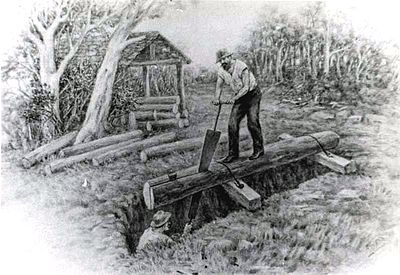Handsaw: Difference between revisions
From DT Online
m (Added link) |
(Added Template) |
||
| Line 1: | Line 1: | ||
[[File:Pitsaw00.jpg|400px|right|link=https://commons.wikimedia.org/wiki/File:Pitsaw00.jpg|Pitsaw00]] | |||
__TOC__ | |||
=====Description===== | |||
[http://en.wikipedia.org/wiki/Hand_saw '''Handsaws'''] have teeth cut along the edge of a [http://en.wikipedia.org/wiki/Tempering_%28metallurgy%29 tempered] steel blade, and a handle, but no stiffener along the back which enables them to make long cuts or across wide pieces of timber. | [http://en.wikipedia.org/wiki/Hand_saw '''Handsaws'''] have teeth cut along the edge of a [http://en.wikipedia.org/wiki/Tempering_%28metallurgy%29 tempered] steel blade, and a handle, but no stiffener along the back which enables them to make long cuts or across wide pieces of timber. | ||
=====Features and Applications===== | |||
The most common types are shown ''(from top to bottom)'' : | The most common types are shown ''(from top to bottom)'' : | ||
| Line 6: | Line 15: | ||
| '''[[Ripsaw]]''' | | '''[[Ripsaw]]''' | ||
| - used for cutting along the length of boards to reduce their width or produce long strips. Typically they are approximately 650mm long and with 6 to 8 teeth per inch ''[[Teeth per Inch|(TPI)]]''. The teeth are sharpened at 90° to the blade to to create a chisel action which enables them to cut with the [https://en.wikipedia.org/wiki/Wood_grain '''Grain''']. | | - used for cutting along the length of boards to reduce their width or produce long strips. Typically they are approximately 650mm long and with 6 to 8 teeth per inch ''[[Teeth per Inch|(TPI)]]''. The teeth are sharpened at 90° to the blade to to create a chisel action which enables them to cut with the [https://en.wikipedia.org/wiki/Wood_grain '''Grain''']. | ||
|[[File:RipSaw.jpg|300px]] | |[[File:RipSaw.jpg|300px|link=http://www.amazon.co.uk/gp/product/B001E19U8W/ref=as_li_tl?ie=UTF8&camp=1634&creative=6738&creativeASIN=B001E19U8W&linkCode=as2&tag=dton06-21]] | ||
|- | |- | ||
| '''[[Crosscut Saw]]''' | | '''[[Crosscut Saw]]''' | ||
| - used for cutting across wide boards and for this reason the teeth are filed at around 75° to the blade to create a knife action. Typically they are approximately 600mm long and with 8 to 10 teeth per inch ''[[Teeth per Inch|(TPI)]]''. | | - used for cutting across wide boards and for this reason the teeth are filed at around 75° to the blade to create a knife action. Typically they are approximately 600mm long and with 8 to 10 teeth per inch ''[[Teeth per Inch|(TPI)]]''. | ||
|[[File:CrosscutSaw.jpg|250px]] | |[[File:CrosscutSaw.jpg|250px|link=http://www.amazon.co.uk/gp/product/B001E19U96/ref=as_li_tl?ie=UTF8&camp=1634&creative=6738&creativeASIN=B001E19U96&linkCode=as2&tag=dton06-21]] | ||
|- | |- | ||
| '''Panel Saw''' | | '''Panel Saw''' | ||
| - a shorter version at about 500mm long and usually with crosscut teeth around 10 to 14 teeth per inch ''[[Teeth per Inch|(TPI)]]''. They are used mainly for cutting sheets of thin '''[[Manufactured Board|Ply]]''' to size. | | - a shorter version at about 500mm long and usually with crosscut teeth around 10 to 14 teeth per inch ''[[Teeth per Inch|(TPI)]]''. They are used mainly for cutting sheets of thin '''[[Manufactured Board|Ply]]''' to size. | ||
|[[File:PanelSaw.jpg|200px]] | |[[File:PanelSaw.jpg|200px|link=http://www.amazon.co.uk/gp/product/B0015GRN8K/ref=as_li_tl?ie=UTF8&camp=1634&creative=6738&creativeASIN=B0015GRN8K&linkCode=as2&tag=dton06-21]] | ||
|- | |- | ||
| colspan="3"| | | colspan="3"| | ||
| Line 29: | Line 38: | ||
Woodcutting machinery such as a circular saw is extremely dangerous and must only be used by adults who have received appropriate training.</span> | Woodcutting machinery such as a circular saw is extremely dangerous and must only be used by adults who have received appropriate training.</span> | ||
---- | ---- | ||
{{Hand Saws Buyers Guide}} | |||
[[Category:Secondary]] | [[Category:Secondary]] | ||
[[Category:Cutting Tools]] | [[Category:Cutting Tools]] | ||
Latest revision as of 12:36, 20 August 2016
Description
Handsaws have teeth cut along the edge of a tempered steel blade, and a handle, but no stiffener along the back which enables them to make long cuts or across wide pieces of timber.
Features and Applications
The most common types are shown (from top to bottom) :
| Ripsaw | - used for cutting along the length of boards to reduce their width or produce long strips. Typically they are approximately 650mm long and with 6 to 8 teeth per inch (TPI). The teeth are sharpened at 90° to the blade to to create a chisel action which enables them to cut with the Grain. | 
|
| Crosscut Saw | - used for cutting across wide boards and for this reason the teeth are filed at around 75° to the blade to create a knife action. Typically they are approximately 600mm long and with 8 to 10 teeth per inch (TPI). | 
|
| Panel Saw | - a shorter version at about 500mm long and usually with crosscut teeth around 10 to 14 teeth per inch (TPI). They are used mainly for cutting sheets of thin Ply to size. | 
|
Note: Handsaws remain useful for general work especially on-site. They are now stamped out of steel alloy sheet with hardened teeth such that they tend to be replaced when blunt rather than sharpened. The top of the blade of a modern handsaw can be used as a straight edge and the handles are shaped such that the saw can also be used on-site as a Try Square or Mitre Square.
In the workshop handsaws have largely been replaced by Bandsaws, Table Saws, Mitre Saws, and Circular Saws.
Safety Point! Woodcutting machinery such as a circular saw is extremely dangerous and must only be used by adults who have received appropriate training.
 |
 |
 |
 |
 |
| 8-TPI Universal Woodsaw |
Traditional Skew Back Woodsaw |
First Fix Woodsaw |
Second Fix Woodsaw |
Fine Cut Hand Saw |

